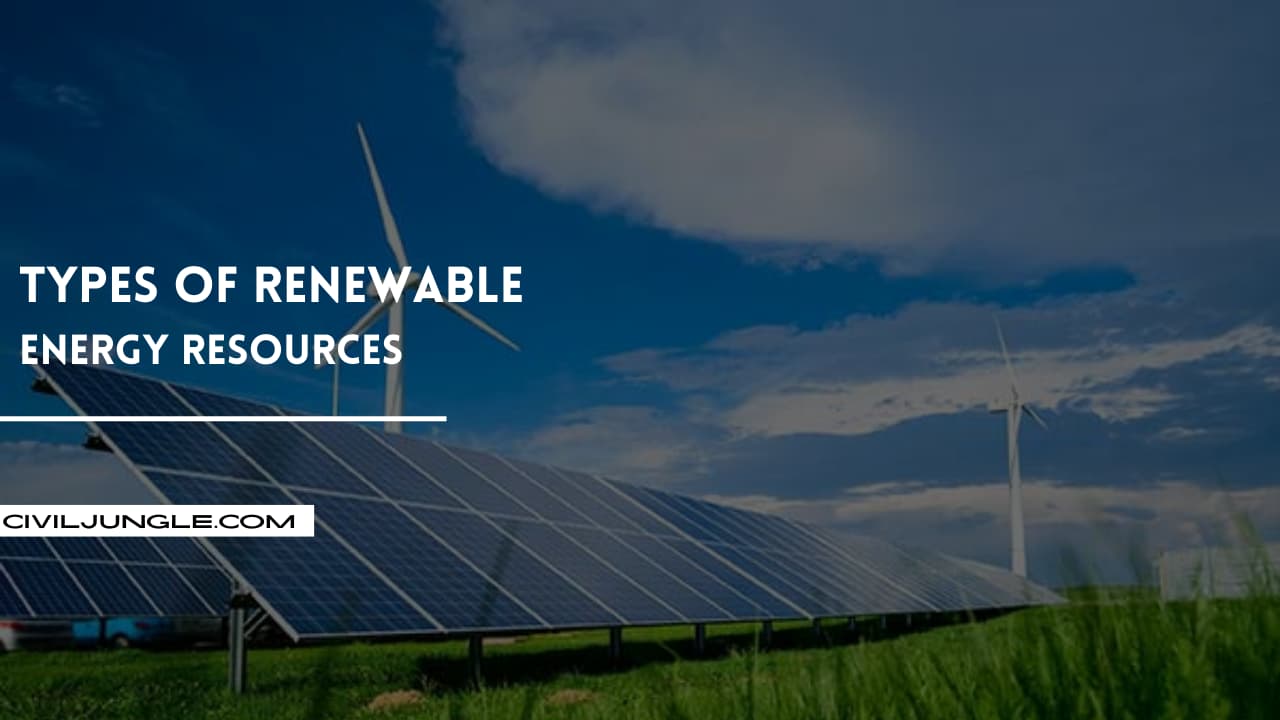
Types of Renewable Energy Resources
In all over the world, scientists have found six number of renewable energy resources, which are ready to use for commercial and industrial purposes, those are in the following-
1. Solar Energy
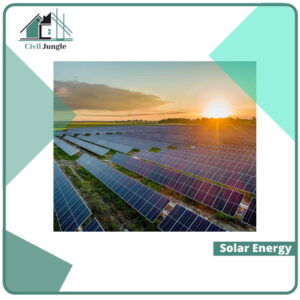
Solar energy is the primary and one of the best renewable energy resources among all other types of renewable energy. In solar energy, sunlight needs and it is available in every place.
The amount of sunlight which is stored in one hour is enough for the total energy of the whole planet for one year. Solar energy is now used to operate vehicles by using solar panels. It also reduces environmental pollution.
The main advantage of using solar energy is it can be used from any location of the planet. The demand for solar energy is increasing day by day in some countries like USA, UK, India, Bangladesh, etc.
2. Wind Energy
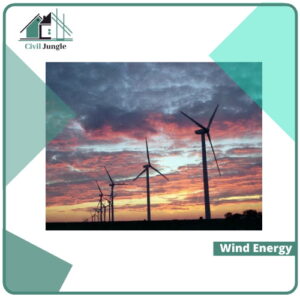
Wind energy is that type of renewable energy which is second largest, and the usage of wind energy is just after solar energy. Wind energy plant is used in the coastal areas and deserts because the wind speed of those areas are higher than other areas.
Here, turbines drive generators which generate electricity and after that electricity will be supplied to the cities. Wind turbines is only constructed for commercial purpose, and it is not constructed for personal property or personal usage.
3. Hydro Energy
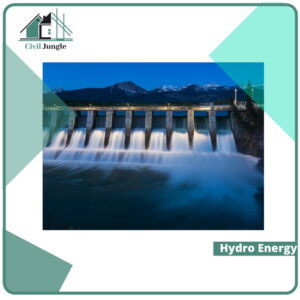
Hydro energy is the most commercially profitable renewable energy in all other renewable energy. The generating of hydro energy is very easy and economical because you just need to construct a dam or reservoir, or a barrier to store a huge amount of water, then you drive turbines through the power of water and generate electricity by driving a generator.
Hydro energy is very much reliable than solar energy or wind energy. This is the only type of renewable energy which can be stored because if you store the water, then you indirectly store the energy, so when the electricity demand is high, then you can use this energy according to the requirement. The one disadvantage of this energy is the initial cost of hydro energy is too much high.
4. Tidal Energy
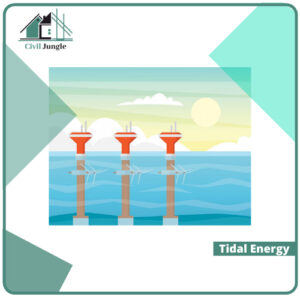
Tidal energy is a modern type of renewable energy which is very popular nowadays. In tidal energy, the energy is stored in two times per day.
Tidal energy is one type of hydro energy because tide comes two times per day in a river. But if the tide is not so much strong, then the electricity generation is also very low.
5. Geothermal Energy
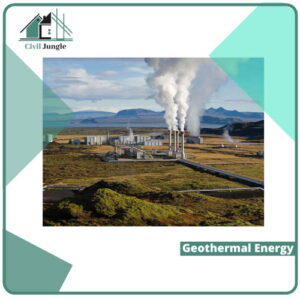
Geothermal energy is another type of renewable energy. Geothermal energy is stored in the earth, and it is generally for heating purposes of homes. Geothermal energy is a less important energy which is widely used the countries like UK, Iceland, etc.
6. Biomass Energy

Biomass energy is the last type of renewable energy, which is basically the conversion of solid turns to electricity. In biomass energy, It includes organic compounds to generate electricity.
Biomass energy is the most efficient and clean process. Biomass energy requires lowest cost energy and economical type of renewable energy.
What Are Renewable Energy Resources?
Renewable energy resources mean those natural energies which are never finished, which are sustainable, which are endless.
Renewable energies are alternative energies because we generally use non-renewable energies as our primary energies. Renewable energies are the substitute of non-sustainable energy like coal energy, petroleum, etc.
Examples of renewable energies are-
- Solar energy
- Wind energy
- Tidal energy
- Biomass energy
- Geothermal energy
- Hydro energy
Why Use Renewable Energy Resources?

There are various reasons are there for using renewable energy resources, those are in the following-
1. Better for the Environment
All the non-renewable energies are produced from fossil fuels, and those products damage the whole environment very much. These are the main cause of the increase global warming. Due to global warming, icebergs melt the seal level is rising day by day.
Renewable energies are more recycled and sustainable products, and it does not harm the surrounding environment. That’s why renewable energy provides a better atmosphere for living.
2. Better for Human Health
Burning of fossil uses will increase the hydrocarbon and particulate matter density in the surrounding air.
But if we use renewable energies like solar energy, wind energy, tidal energy, etc, then the particulate matter density will reduce, and the air pollution will also decreased because renewable energies do not harm the environment.
3. Energy in Abundance
We need to use renewable energy because there are plenty amount of renewable resources. But in non-renewable resources like coal, it will definitely finished one day then, you can not produce any further energy from that.
4. Cheaper to Run
We use renewable energies because the cost of renewable energy is very low, so everyone can afford it easily. The initial cost of the renewable energy equipments are very much costly but after that it will easily be affordable for others. So, those are main reasons why we use renewable energy resources.
Frequently Asked Questions (FAQ) about Renewable Energy Resources
What Are Renewable Energy Resources?
Renewable energy resources are natural energy sources that are sustainable and inexhaustible. They include solar energy, wind energy, hydro energy, tidal energy, geothermal energy, and biomass energy. These energies are alternatives to non-renewable resources like coal and petroleum.
Why Is Solar Energy Considered One of the Best Renewable Energy Sources?
Solar energy is abundant, available everywhere, and capable of producing enough energy in one hour to power the entire planet for a year. It is also environmentally friendly, reducing pollution and offering a reliable energy source from any location on Earth.
Where Is Wind Energy Most Effectively Harnessed?
Wind energy is most effective in coastal areas and deserts, where wind speeds are higher. Wind turbines in these areas drive generators that produce electricity for commercial use.
How Is Hydro Energy Generated and Stored?
Hydro energy is generated by constructing dams, reservoirs, or barriers to store large amounts of water. The stored water drives turbines connected to generators, producing electricity. This energy can be stored by holding water in the reservoir, allowing for controlled release based on electricity demand.
What Makes Tidal Energy a Modern and Popular Renewable Energy Source?
Tidal energy harnesses the power of tides, which occur twice daily. This method of energy generation is a type of hydro energy. Its popularity stems from its reliability and the potential to produce significant amounts of electricity, especially in areas with strong tides.
What Is Geothermal Energy, and Where Is It Commonly Used?
Geothermal energy is stored within the Earth’s crust and is primarily used for heating purposes. It is especially popular in countries like the UK and Iceland. This type of energy is less prominent but offers a sustainable heating solution.
How Does Biomass Energy Work, and What Are Its Benefits?
Biomass energy involves converting organic compounds into electricity. It is an efficient and clean process that requires low-cost inputs, making it an economical renewable energy source.
Why Should We Use Renewable Energy Resources Instead of Non-Renewable Ones?
Renewable energy resources are better for the environment and human health, as they produce less pollution and help combat global warming. They are also abundant and sustainable, ensuring a continuous energy supply. Additionally, while the initial setup cost can be high, renewable energy systems are cheaper to run in the long term.
What Are the Main Environmental Benefits of Using Renewable Energy Resources?
Renewable energy resources reduce the need for fossil fuels, thereby decreasing greenhouse gas emissions and air pollution. This leads to a healthier environment, less global warming, and a reduction in the melting of icebergs and rising sea levels.
How Do Renewable Energy Resources Impact Human Health?
By reducing the burning of fossil fuels, renewable energy resources lower the density of hydrocarbons and particulate matter in the air. This results in cleaner air, reducing respiratory and cardiovascular diseases associated with air pollution.

